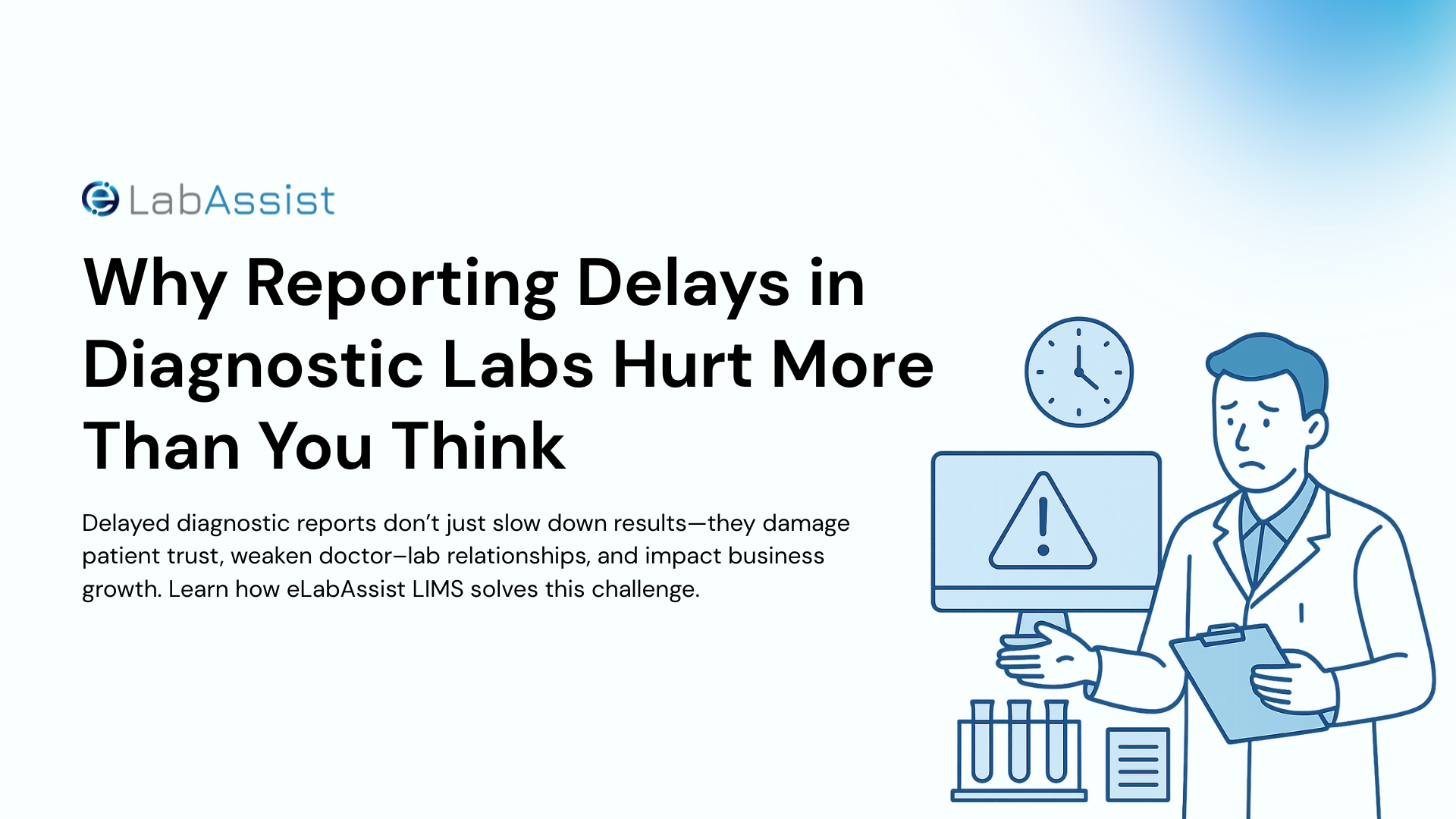
201,Chandravarsha Commercial Complex, Pashan, Pune

Sales:+91 7447789075

Sales:+91 7276004413

sales@elabassist.com

Why Reporting Delays Hurt Diagnostic Labs & How eLabAssist LIMS Helps
September 22, 2025
Why Speed Matters in Diagnostic Labs?
In today’s fast-paced healthcare ecosystem, lab report turnaround time is not just about efficiency—it’s about patient outcomes, trust, and the reputation of your diagnostic centre. Every minute counts when doctors are waiting for pathology or radiology results to begin treatment. Yet, many labs still struggle with reporting delays in diagnostic labs, leading to frustration for patients, strained doctor–lab relationships, and even financial losses.
The impact of delayed lab reports goes far beyond inconvenience. It can delay critical treatment decisions, create distrust among doctors, and cause patients to switch to competing centres. The solution? Leveraging modern technology like a Lab Information Management System (LIMS for diagnostic labs) to streamline processes and ensure accuracy, speed, and reliability.
The Hidden Impact of Reporting Delays in Diagnostic Labs
1. How Reporting Delays Affect Patient Care
Patients today expect faster pathology reports. A test result is often the key to diagnosing serious illnesses, from infections to chronic conditions. When reports are delayed, patients are left anxious and uncertain about their health.
- Increased stress: Waiting longer than necessary adds emotional strain.
- Delayed treatment: Critical illnesses like cancer, diabetes, or infections worsen when treatment decisions are postponed.
- Loss of confidence: Patients begin to doubt the lab’s professionalism and may look for more reliable providers.
2. Consequences of Late Diagnostic Test Results on Doctors
Doctors rely on timely test reports to make accurate treatment decisions. Diagnostic reporting errors or delays can severely affect their ability to provide quality care.
- Doctors lose trust in labs that consistently deliver late results.
- They may refer patients to other labs with better efficiency.
- In emergencies, late reports can directly compromise patient safety.
Maintaining a strong doctor–lab relationship depends heavily on the accuracy of diagnostic reports and punctual delivery.
3. Financial & Business Losses for Diagnostic Centres
Reporting delays don’t just harm patients and doctors—they hurt the lab’s bottom line too.
- Dissatisfied patients won’t return, reducing repeat business.
- Negative word-of-mouth damages reputation in the community.
- Delays increase operational costs due to repeat testing or manual follow-ups.
Over time, labs that fail to improve lab report turnaround time risk losing their competitive edge.
Why Do Reporting Delays Happen in Diagnostic Labs?
Understanding the causes is the first step to solving the problem. Common reasons include:
- Manual processes: Paper-based reporting slows down data entry and increases the chances of errors.
- Unorganised sample tracking: Lost or misplaced samples extend delivery time.
- Poor coordination: Lack of communication between collection centres, technicians, and doctors.
- Authentication bottlenecks: Reports waiting for senior pathologist approval often pile up.
- Accounting and billing delays: Manual billing distracts staff from focusing on core lab work.
These issues can be minimised—or even eliminated—with the right technology.
Why Fast Lab Reports Are Important: Patient Trust & Reputation
1. Patient Trust in Diagnostics
Patients associate timely reports with quality care. If your lab consistently delivers reports quickly, it builds long-term trust.
- Transparency & reliability → patients feel valued.
- Consistency → patients are more likely to recommend your lab.
- Convenience → faster results mean reduced stress.
2. Strengthening Doctor–Lab Relationship
Doctors prefer to work with labs that make their practice smoother. On-time reports ensure doctors can confidently recommend your services to patients.
- Doctors see you as partners, not just service providers.
- Trustworthy relationships bring in continuous referrals.
- Faster reports mean quicker clinical decisions, which strengthen the doctor’s credibility, too.
The Role of LIMS in Fixing Reporting Delays
A Lab Information Management System (LIMS) is no longer a luxury—it’s a necessity for modern diagnostic centres. Let’s see how LIMS for diagnostic labs addresses the challenges:
1. Automating Report Generation
- Eliminates manual data entry errors.
- Speeds up the entire process from test completion to report creation.
- Ensures reports are available in digital format instantly.
2. Improving Sample Tracking
- Every sample is barcoded and tracked through its lifecycle.
- Reduces chances of misplaced or delayed samples.
- Provides real-time status updates.
3. Ensuring Accuracy of Diagnostic Reports
- Automated result entry reduces transcription mistakes.
- Integrated checks highlight anomalies before finalization.
- Enhances overall accuracy of diagnostic reports.
4. Faster Authentication & Doctor Sign-Off
- Remote report authentication allows pathologists to approve reports securely, even offsite.
- Cuts down waiting time for patients.
5. Enhancing Patient & Doctor Experience
- Patients can access reports online or via mobile apps.
- Doctors get reports directly in their dashboard or via email/SMS.
- Improves transparency and communication.
Reducing Errors and Delays in Pathology Labs with LIMS
Without LIMS, labs depend on manual entry and paperwork, which naturally increases diagnostic reporting errors. By adopting lab efficiency software, labs can:
- Standardize test procedures and workflows.
- Maintain error logs for quality control.
- Analyze turnaround times to continuously improve efficiency.
This shift not only reduces delays but also ensures compliance with medical standards.
Why eLabAssist LIMS is the Best Software for Diagnostic Reporting in India.
Indian diagnostic centres are rapidly expanding, and patients expect services that match global standards. The best software for diagnostic reporting in India is one that:
- Offers cost-effective automation for mid-sized labs.
- Supports both B2C (patients) and B2B (hospitals, doctors) needs.
- Enables mobile accessibility for reports, billing, and payments.
With LIMS like eLabAssist, labs not only speed up lab report turnaround time but also future-proof their operations for scalability.
Future of Diagnostic Labs: Efficiency Is the New Standard
The future belongs to diagnostic centres that embrace lab efficiency software. Patients and doctors no longer tolerate excuses for delays when technology exists to eliminate them. Whether it’s reducing errors and delays in pathology labs or improving doctor referrals, adopting LIMS is a strategic move for both survival and growth.
Time to Eliminate Reporting Delays
The impact of delayed lab reports is too severe to ignore. They hurt patient care, damage doctor–lab relationships, reduce trust, and cause financial losses. But with a modern Lab Information Management System, diagnostic centres can transform their workflows—delivering reports faster, more accurately, and more reliably.
In a competitive healthcare landscape, the labs that thrive will be those that put speed, accuracy, and trust at the core of their services. LIMS is not just software—it’s the bridge between operational efficiency and long-term success.
